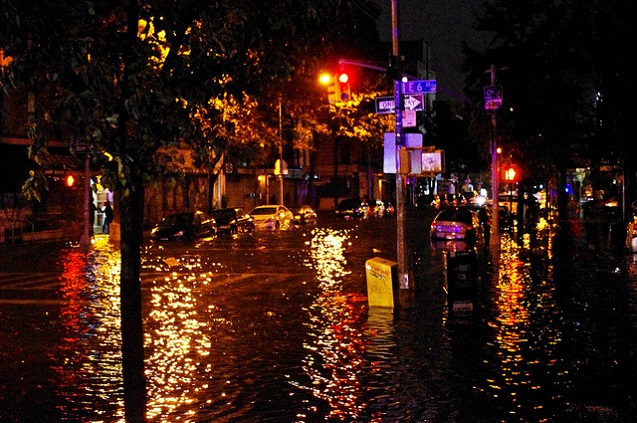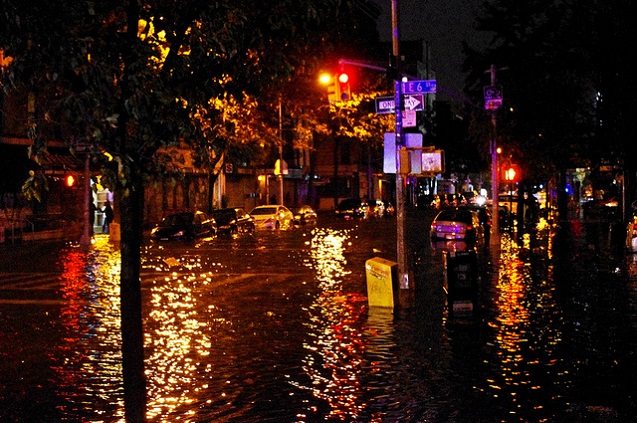
 David Shankbone / Flickr)” width=”637″ height=”423″ />Hurricane Sandy flooding on Avenue C at East 6th Street, moments before the ConEdison power substation at Avenue C and 14th Street blew and the neighborhood lost electricity. October 29, 2012. (Photo: David Shankbone / Flickr)
David Shankbone / Flickr)” width=”637″ height=”423″ />Hurricane Sandy flooding on Avenue C at East 6th Street, moments before the ConEdison power substation at Avenue C and 14th Street blew and the neighborhood lost electricity. October 29, 2012. (Photo: David Shankbone / Flickr)
Following Superstorm Sandy, donors gave $312 million to the American Red Cross. How did the aid organization spend that money?
A year and a half after the storm, it’s surprisingly difficult to get a detailed answer.
Red Cross officials told ProPublica the organization has spent or committed $291 million on Sandy through the end of February 2014. But the organization has not given a breakdown showing how, where, and when the money was spent.
“The Red Cross is too big and too important to be allowed to be this secretive,” said Doug White, a charity expert who has written extensively on nonprofit finances.
White said such a lack of transparency is common among charities. Like other non-profits, the Red Cross is required to disclose only top-line numbers on its fundraising and spending, which it publishes in an annual report and a standard tax filing.
But the Red Cross stands out both for the scale of its operations and the unique role it plays in domestic disasters.
It is the first call for many people moved by images of a tornado, flood, or fire ravaging a community. The organization is also a strange hybrid: a nonprofit charity, it also has a congressional charter. It gets little money from the federal government but it has an official role doing disaster relief in partnership with the Federal Emergency Management Agency. President Obama is its honorary chairman.
In contrast to the Red Cross, there is a wealth of information available about Sandy relief money that has flowed from the federal government to states and towns. (That has allowed for attendant media scrutiny.)
Despite its beloved name, the Red Cross has had a rocky decade and a half.
Allegations of mismanagement of funds and poor performance followed both Sept. 11 and Katrina.
A series of CEOs were forced out — one after Sept. 11, another after Katrina, and a third following an affair with a subordinate. Congress in 2007 imposed a set of governance reforms, including reducing the size of the organization’s 50-member board.
Appointed as CEO in 2008, former AT&T executive Gail McGovern has had a longer run than her predecessors and won praise as a competent manager. But the Red Cross faced familiar criticism after the 2010 Haiti earthquake.
The Red Cross weathered more criticism almost immediately after Sandy hit in October 2012. As donations poured in, partly on the strength of appeals from Obama and a star-studded televised benefit concert, residents on Staten Island and the Rockaways complained the Red Cross was missing in action.
When it comes to its Sandy spending, the Red Cross gives a dollar-figure breakdown in only the broadest of categories: Food and Shelter, Individual Casework, Housing and Community Assistance, and Relief Items are the four biggest.
The Red Cross also gives raw numbers of services provided in a different set of categories: emergency vehicles activated; relief items distributed; overnight stays in shelters provided; health and mental health contacts provided; meals and snacks served; and workers and volunteers mobilized.
Because the spending isn’t categorized in the same way as the numbers of services provided, one can’t calculate, for example, how much it cost for the Red Cross to provide 74,000 overnight shelter stays or what exactly it purchased for the $85 million it spent on individual casework.
Citing its finance tracking system, the Red Cross said it could not match up the categories for us.
“It would be helpful to know where people received assistance and how much, and when,” said Ben Smilowitz, the founder of the Disaster Accountability Project, who has tracked the Red Cross since Hurricane Katrina. “You might actually see that some neighborhoods received more than others in equal need.”
“Aggregate data does not tell you a whole lot,” Smilowitz added. “If the data was open, they would be inviting a lot of scrutiny.”
Red Cross spokeswoman Anne Marie Borrego said the group continually updates its website with stories about how it is spending disaster donations.
“The Red Cross issues regular reports about our spending and programs for disasters such as Sandy,” she said.
Another obstacle to tracking Red Cross spending lies in the phrase “spent or committed.” The Red Cross generally combines the two activities in its totals. The amount that it commits, rather than spends, can be considerable. When the Red Cross “commits” funds, that typically means it has made a decision to grant money to a smaller organization, such as a local soup kitchen. The Red Cross then usually parcels out the money over time. The money hasn’t immediately been put to work helping victims.
Critics argued after Sandy the Red Cross wasn’t spending donor dollars quickly enough. But the way the organization releases figures makes it impossible to judge how fast money has been getting out the door. The Red Cross declined to give a breakdown over time of money spent and committed versus money spent.
Among other new details in response to ProPublica questions:
- The Red Cross counts as Sandy spending some amount of overhead — specifically a portion of the annual cost of maintaining “permanent disaster response infrastructure.” It wouldn’t say how much money.
- While the Red Cross says it spends an average of 91 cents of every dollar on programs and services, a bit less may go to actually help victims. That’s because, the Red Cross told us, it keeps 9 percent of total Sandy donations for “general operations support” even on the $78 million it has passed on to other organizations, which in turn have their own overhead and other expenses.
-
The Red Cross said it limits a grantee’s administrative costs to just 3 percent because the groups it gives money to are already up and running. The 3 percent allowance “is designed to account for the incremental cost” of particular Sandy projects, the Red Cross told us.
- The Red Cross acknowledged that it produces after-action reports following disasters like Sandy to figure out what went well and what didn’t. But the organization said they are for “internal use” and declined to provide copies.
Join us in defending the truth before it’s too late
The future of independent journalism is uncertain, and the consequences of losing it are too grave to ignore. To ensure Truthout remains safe, strong, and free, we need to raise $43,000 in the next 6 days. Every dollar raised goes directly toward the costs of producing news you can trust.
Please give what you can — because by supporting us with a tax-deductible donation, you’re not just preserving a source of news, you’re helping to safeguard what’s left of our democracy.